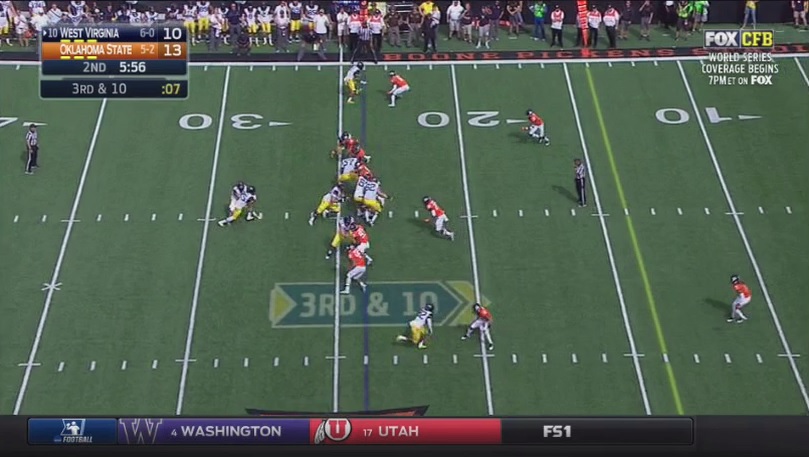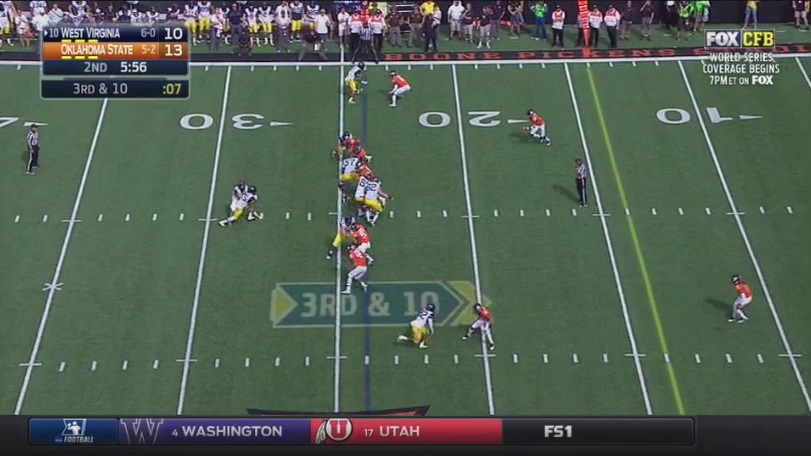The Good and the Bad of WVU v. Oklahoma State
November 2, 2016 by Mike Casazza
This is probably the neatest play for West Virginia Saturday, and it didn’t count. It might have mattered, because WVU was in Oklahoma State territory with 5:00 and three timeouts to go, but it didn’t happen. Still, it was another way to weaponize Jovon Durante’s skills, which the Mountaineers are doing more and more of, and of course there was that cool block when running back Justin Crawford flipped a defender.
But that’s illegal, even though I thought it was legal because Crawford is clearly square with the defender and he’s not blocking back toward the line of scrimmage. The officials got this right, according to WVU, because of where Crawford started and where he ended up on the play.
“You can’t go outside-in,” running backs coach JaJuan Seider said. “You can go inside-out.”
This is a play WVU likes to run when safeties choose to stay on top of Shelton Gibson and Ka’Raun White outside, and you’ll remember Daikiel Shorts getting lit up earlier in the game when a linebacker worked around Kennedy McKoy. But this play was also different, and watch Crawford look around and try to find someone when he first arrives in that space.
“He was actually going to block their Sam/nickel guy, but he ran off,” Seider said. “All of a sudden you look and see a guy coming 90 m.p.h. at you, what do you do? Do you hit him high? Who knows. You may get called for targeting. I don’t know. I didn’t coach that decision. It’s my fault as a coach. I never thought he’d be in that situation, and he reacted.”
It backed the offense up into second-and-long, and Skyler Howard’s quizzical interception on third down was the end of that. What a day for Crawford, though. His ankle was damn near mummified still, but he wound up getting 16 touches when he probably wasn’t anticipating that. I fact, I don’t think anyone was, not merely because Rushel Shell was injured in the second quarter, but because Seider had McKoy ready to go and actually used him before he used Crawford.
The hallmarks of Crawford’s day, though, were things that didn’t happen. There’s the play at the top and then there’s this.
We’ve been impressed by Tony Matteo, the starting left guard, this season. Some of his work is unheralded — since he’s good, Adam Pankey could move to left tackle — and some of it is easy to spot — he pulls a lot and clears the way on power plays. It doesn’t happen here, and that was surprising. Chad Whitener (Side Good: That guy!) moves out of the way and makes the play before it turns into anything.
And it was going to turn into something
If Matteo takes Whitener out of the play, Crawford gets the yardage he needs, right? I mean, look at all that space. Kyle Bosch has the strong safety, and Crawford has a 1-on-1 with the free safety.
Instead, it doesn’t work out like it’s supposed to and like it often does, and Mike Molina misses a 39-yard field goal. The theme of the week at the Puskar Center, it seems, is making big plays, and it’s missed opportunities like this and some other occasions that make it such an important topic.
The other thing folks over there are discussing is doing something defensively to affect the game. Apart from Rasul Douglas putting his helmet on a ball to force an incomplete pass, the defense didn’t do much in the line of breaking up plays or creating even chances for turnovers. Not only that, but there were key third down conversions — ridiculous ones and ones at critical times — as well as that double reverse flea flicker that just shouldn’t have happened.
And, of course, there were the Cowboys scores after WVU miscues. Seventeen-points off turnovers and the touchdown at the end of the half that followed Molina’s miss — and we need to discuss that whole ordeal, because it was a signature stretch in the 37-20 loss to Oklahoma State. How did we get here? Let’s find out by taking a look at the Good and the Bad of WVU v. Oklahoma State.
Bad: This whole sequence
Here’s the first down play before Crawford’s run and Molina’s miss. What’s Howard doing? He seems to watch McKoy the whole time. Daikiel Shorts, who is the slot receiver, has a bunch of space. Gary Jennings, the receiver up top, is inside his defender. I can’t speak for the simplicity of either play — though Howard is ordinarily very good at feeling the blitz and throwing to that area, which is where he would have found his favorite receiver — but I do know McKoy’s not interested in making this catch, and I can’t blame him. He and his defender look surprised.
Howard kept the ball on the next play and got nothing, and Dana Holgorsen walked onto the field to have a word with his quarterback. It wasn’t an explosion or even very animated. I suspect he wasn’t calling a play with defenders in the vicinity, either. I have to think there was some advice in there.
Anyhow, Crawford gets tackled and Molina pushes one right. On Tuesday, Holgorsen called it “a pitiful three-play sequence.” On Saturday, I said it was “as shaky as WVU has looked this year.” I have to think you agreed with one or the other and I bet the Cowboys sensed an opportunity was afoot. So, they go to work to end the half, and they know they get the ball to start the third quarter. It’s abundantly clear points are going to be important.
There are three third-down conversions in the first 10 plays of the drive, so WVU was close to getting off the field. On second-and-2 at the WVU 15-yard line, Justice Hill gains a hard, and Maurice Fleming, for some reason only he knows, jets toward the line of scrimmage and blasts an offensive lineman in the back. Personal foul. Half the distance to the goal. First down.
The drive started with 5:16 to go. WVU had three timeouts. First-and-goal begins with 1:51 and three timeouts, though the clock is rolling and the snap happens 13 seconds later. Hill runs and gets 1 yard. The play is whistled dead with 1:34 remaining. No timeout. OK, I guess. Use one on second and third down and keep one for the offensive possession. The clock is rolling on Oklahoma State, and Mike Gundy …
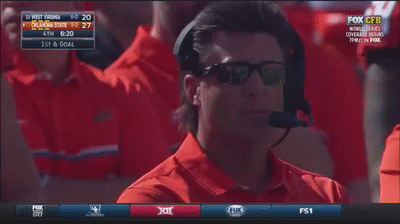
… Mike Gundy calls a timeout with 57 seconds to go. Hill gains 7 yards, and the whistle blows with 52 seconds left and starts the play clock. No timeout? Not OK! And then it gets worse. The Mountaineers get confused and out of position before the snap.
That’s a 3-on-2 at the bottom of the screen, because Jeremy Tyler — poor Jeremy Tyler … couldn’t even get a snap off to deal with his arm — was moving around before the snap. I guarantee you Tony Gibson did not design it that way. But I do think WVU got tricked. The Cowboys used this formation throughout the game, and it gave the Mountaineers some problems. (Side Bad: Oklahoma State’s tempo really bothered WVU, and that was surprising. The Mountaineers have a simple way to combat tempo with how they line up and how they get the play called, but the Cowboys, for some reason, gave them issues.) Hill’s runs before this were out of this formation, with one twist. He was in the pistol on those runs, which means he’s behind the quarterback and you have to guess or wait to see if he’s going left or right. On this play, Chris Carson is in the backfield, and he’s to Mason Rudolph’s left, which suggests a run play will go to the right.
Tyler is quite likely communicating that because the Mountaineers just saw this.
So good on Tyler for reading it, except for the part about getting back to his spot. The Cowboys weren’t done with this slight of hand in the red zone, either.
WVU actually covers the run and the screen. Watch the defense flow left to track Hill. Watch the defenders at the bottom of the screen step forward to handle a screen. And then watch Rudolph keep it.
That’s two third-and-goal touchdowns, by the way.
But getting back to the initial point, had WVU used one or two timeouts toward the end of the possession at the end of the half, it’s taking the field with plenty of time and at least one timeout. Getting into field goal range is not out of the question. The Mountaineers needed points and needed to use the available resources. Better management would have given them a look at points, but — and here’s the theme — it didn’t happen.
Again and again, WVU fell short of doing something to shape the outcome of the game, but this example is different than all the others. A penalty committed, a third down conversion allowed, a block missed, a field goal pushed wide, some of that is out of your control and some of that is just competition and consequence. Frittering away close to or more than a minute off the clock is in a separate category.
Good: Formations!
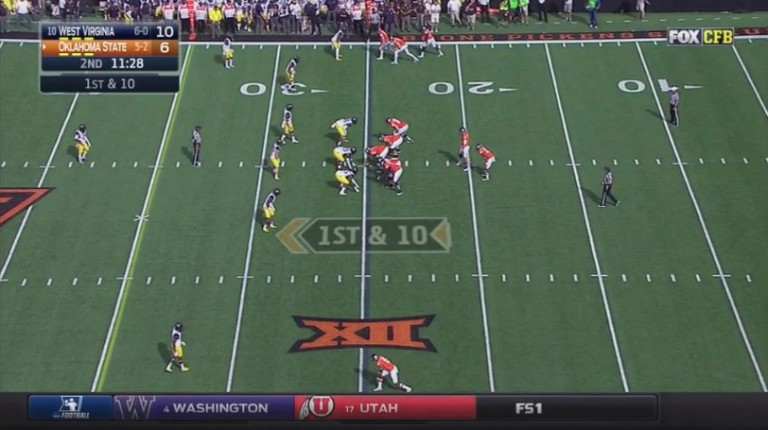
Oklahoma State stacked receivers on one side now and again throughout the game, but that’s not new. I hadn’t seen this. That’s a good way to create space, keep WVU from crowding the line and create a 1-on-1 at the bottom of the screen for 6-foot-3, 205-pound Chris Lacy.
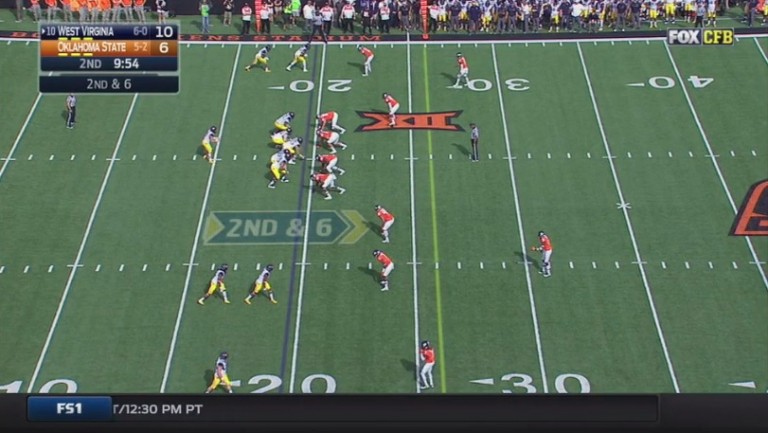
Here’s WVU debuting something. We saw the twin stacks with a slot receiver previously. This just flips the slot and the stack, but doing so does bring a defender inside. WVU wound up running here, too.
Good: Unveilings
That’s a power play with a read. I doubt Howard would ever pitch it to Shell to make it a triple option, but, hey, who knows? Later, though, we saw a variation on a triple option where one of his options is a bubble outside.
Meh?: Offensive line
Dana, your thoughts?
Okay, okay. Not bad, not great. We had four sacks, two of them were on the o-line, two of them were on the quarterback. Threw it over 40 times. We’re not talking about catastrophe. It’s better than it was at any point last year. That’s not what happened. We had adequate time to throw the football.
I can dig it. Blocked very well for the run game. I can’t think of a play when they were fooled by a front or a blitz. They did completely whiff on a cut play. There were times when a tackle couldn’t hold the edge, and that’s going to happen across 40 throws. There were times a very good player made a very good play, and Vincent Taylor is a monster inside.
They’re still looking for depth, though. I didn’t see Marcell Lazard. Tyler Orlosky, Colton McKivitz and Pankey played all 80 snaps. And when “a guy got beat” on the Howard sack/strip, it was Grant Lingafelter, who they’ve been trying to get on the field but wouldn’t commit to until he was ready. This is concerning.
But Holgorsen put that play and this play on Howard, which is appropriate. But it’s also a little unfair, because we’ve touted Howard this season for escaping and running or passing out of trouble. Remember this? First drive of the game…
He’s going to need to behave like this to make plays. He’s not a mover like Pat Mahomes or Kenny Hill and he’s not 6-foot-5 like Rudolph with a frame to see over the line or the arm strength/reach to basically hand the ball to a receiver. There’s going to be good and bad plays when Howard’s under duress. You knew that, though you may have forgotten.
Good: James Washington
Pro. The best WVU’s seen this season, but Dede Westbrook will challenge that in three games. I guess this isn’t the best showcase play, but we should talk about slants. This was not good defense here. Washington shakes and bakes Elijah Battle, and Rudolph waits for the defender covering the running back to clear the throwing lane. (Aside: Rudolph does not throw interceptions, and part of that is because of plays like this. He’s keeps the ball out of trouble, and he places throws where they need to be.) For the rest of the game, though, I actually thought WVU did all right against the slants. You can’t cover one a whole lot better than this. This is just a throw where his receiver can go get it and the cornerback cannot.
But!
Watch Battle and Lacy here. Lacy fakes a slant and Battle is finished.
Good: Practice
Well, Ka’Raun White needs to catch this, and later he makes a meal out of a fade that … well, I don’t want to say his brother makes the play, but Kevin White makes the play. The remarkable thing about this play is that even though WVU didn’t make great effort from interception to tackle, there’s not one penalty on this play. Normally somebody does something wrong but not here. Gundyhas your explanation:
“What they’ve done is they’ve practiced, with fumble recoveries and interceptions, blocking in front of the returner, not away from the play, because that’s an automatic 15-yard penalty even if it’s legal, and not blocking below the waist. The time that we’ve put into it and the players’ ability to focus and absorb that information has paid great dividends for us, and today was a good example. You guys have watched a lot of football at this level. Most interceptions or fumble recoveries where a player runs down one sideline for 40 yards, cuts all the way back across the field and goes down the sideline for another 30, you’re gonna get a flag. I told them that the work that they’ve put in and the understanding of what we can and can’t do made a huge difference today. We started on the nine-yard line, when in most cases you get an illegal block in the back and start on your own 30. It’s been really important that our coaches coach it and our players understand it and are able to execute it.”
Good: Luck
I forgot to ask about this Tuesday, and I was a zombie for much of the day, but while this looks like wrong place-wrong time stuff for the defense, I think WVU should get some credit here. It might have been planned this way. WVU used this formation a lot, and Oklahoma State kept blitzing the top corner — there were at least three other instances when this happened on second downs, too. So maybe the double move was prescribed on the sideline and Howard and Gibson were enabled to submit this highlight. But you know what? Planned or not, just enjoy the route and the catch.


